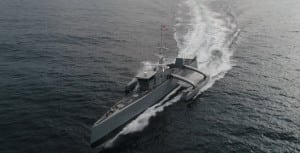The Chief of Naval Operations (CNO) this week said the Navy is creating a new unmanned task force to quicken the pace of integrating unmanned systems into the fleet.
Speaking at the virtual Defense News conference on Sept. 8, CNO Adm. Mike Gilday said he is not yet satisfied with the pace at which the Navy is working with unmanned systems, despite advances like the first Unmanned Integrated Battle Problem (UxS IBP) 2021 conducted in April.
The exercise aimed to evaluate how unmanned systems can
team with manned systems to create warfighting advantage and included tests that used sensors on unmanned vessels to help a missile hit a target beyond line of sight (Defense Daily, April 27).
Gilday said the Navy continues to scale up these battle problems and learn from them.
“It’s helping us conceptually understand how we’re going to employ not just unmanned but unmanned together with traditional ships and platforms.”

He added that the IBPs also “help us make decisions on what type of unmanned platforms we want to sundown because they’re not performing as well as we expected, and which ones we want to double down and accelerate.”
However, Gilday explained that “in the next few months we’ll be standing up an unmanned task force. So think in terms of scope, purpose, similar to Task Force Overmatch, where I have a group of technical experts along with operators who put meat on this problem set to move forward in all three domains at speed, to make unmanned a reality by the end of this decade, so that we can begin to put ourselves in a position where we can scale these assets and really make them an important part of the fleet — make distributed maritime operations come alive in a way that it’s real.”
The CNO would not reveal more details but said they are in the early stages of putting the task force together and by early 2022 he will be able to provide further details.
He said the Navy plans to use internal personnel at the service’s labs and systems commands on the task force.
“So that’s where we’re going first, people with highly specialized skill sets, who have a passion for innovation, and they want to lean in and contribute. So we’re going to leverage the people we have in the Navy right now. Just like we do with Overmatch.”
Project Overmatch is the Navy’s portion of the DoD Joint All-Domain Command and Control effort. Last year, Gilday directed Rear Adm. Douglas Small, commander of Naval Information Warfare Systems Command, to lead the project to help build the Naval Operational Architecture. That architecture aims to support the future naval force of both manned and unmanned ships operating in a distributed manner (Defense Daily, Oct. 15, 2020).
Gilday said if the goal is to have at least a third of the fleet be unmanned or minimally manned by the mid-2030s the Navy would not be able to command and control 100 to 200 of these vessels “without changing the way that we are networked.”
Therefore, he noted Project Overmatch became his second highest priority after building the Columbia-class ballistic missile submarine program on time. Gilday said it is important “in terms of giving us…decision superiority and fusing together networks in a reliable fashion to move data quickly.”
“So this past year, in the first year of Project Overmatch, we’ve done three spirals where we bring together increasing amounts of networks and data sources and see…what we can package and move on what networks at speed.”
We’ve been very optimistic about what we’ve seen so far with respect to performance. Our first big test is going to be in late [fiscal year 2022 or early 2023] on a deploying strike group and after that we will attempt to scale at a fleet level and then continue that effort.”
Gilday said he visited San Diego recently, where Project Overmatch is based with Naval Information Warfare Systems Command, and noted the enthusiasm of Department of Navy employees. He argued they have been empowered to take charge of the project, move forward, fail, learn from failure, and experiment.
“That’s an example for me of what we can do from the inside without going to the outside and contracting for more help.”